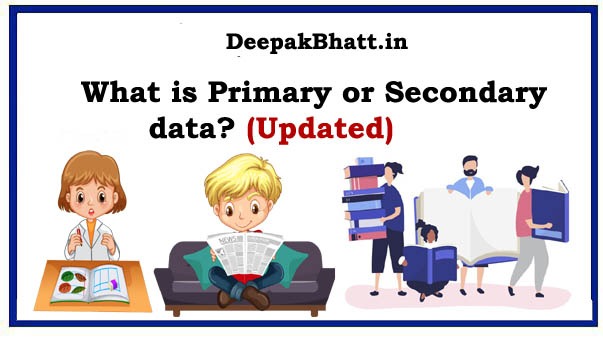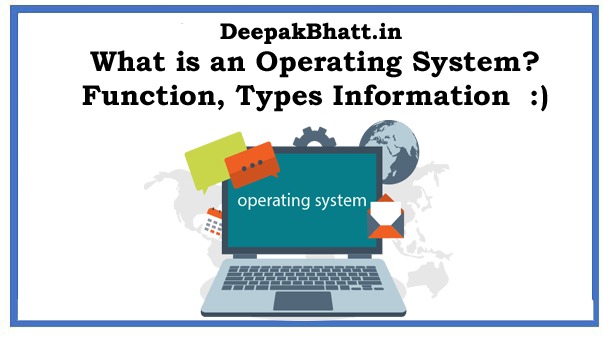What is Primary or Secondary data Every person compiles data according to his need. But this data is collected in two types i.e. –
- 1 What is primary data?
- 1.1 1. Source of Data:
- 1.2 2. Purpose:
- 1.3 3. Originality:
- 1.4 4. Methods of Collection:
- 1.5 5. Control:
- 1.6 6. Accuracy and Reliability:
- 1.7 7. Time-Consuming:
- 1.8 8. Privacy and Ethical Considerations:
- 1.9 9. Examples:
- 1.10 10. Use in Research:
- 1.11 What is Secondary Data?
- 1.12 1. Source:
- 1.13 2. Existing Data:
- 1.14 3. Purpose:
- 1.15 4. Types of Secondary Data:
- 1.16 5. Access:
- 1.17 6. Advantages:
- 1.18 7. Limitations:
- 1.19 8. Citations and Attribution:
- 1.20 9. Examples:
What is primary data?
When any data is collected from beginning to end for the first time by an organization or researcher.
So much data is called primary data or primary data. This is the original data. That is, such data is collected afresh for the first time. It is called primary data.
- It is assembled anew.
- It costs a lot of money to collect it.
- It is very accurate.
- It is very suitable.
- Primary data is very reliable.
- But it also costs a lot of time.
- At the same time, manpower is also needed, that is, people are also needed.
- There is also difficulty in collecting data.
How to Create a Simple Business Plan Free
5 Books Will Make You a Better Entrepreneur Free
1. Source of Data:
Primary data is collected directly from the source, which means it is not already available in existing records, publications, or databases. Researchers gather this data themselves through various methods.
2. Purpose:
The collection of primary data is typically done for a specific research project or study. Researchers gather primary data to answer research questions, test hypotheses, or address specific objectives.
3. Originality:
Primary data is original and has not been previously collected or used in other research. It is unique to the study or project for which it was collected.
4. Methods of Collection:
There are various methods for collecting primary data, including surveys, interviews, observations, experiments, and questionnaires. The choice of method depends on the research objectives and the nature of the data to be collected.
5. Control:
Researchers have control over the data collection process when gathering primary data. This allows them to tailor the data collection methods to suit the research requirements and ensure data quality.
6. Accuracy and Reliability:
When collecting primary data, researchers can take measures to ensure the accuracy and reliability of the information. This can include using standardized data collection instruments, ensuring data consistency, and minimizing bias.
7. Time-Consuming:
Collecting primary data can be time-consuming and resource-intensive. Researchers need to plan, execute, and analyze the data, which may require significant effort.
8. Privacy and Ethical Considerations:
Researchers must consider ethical and privacy issues when collecting primary data from human subjects. Obtaining informed consent, protecting participant anonymity, and following ethical guidelines are important aspects of primary data collection.
9. Examples:
- Some common examples of primary data include:
- Survey responses from individuals or organizations.
- Interviews conducted with participants in a research study.
- Observations made in a controlled setting, such as a laboratory experiment.
- Test results obtained from experiments or clinical trials.
- Data collected through fieldwork, such as environmental data, census information, or market research.
10. Use in Research:
Primary data is valuable in research because it provides data that is tailored to the specific research objectives. It allows researchers to answer questions and test hypotheses that may not be addressed adequately by existing secondary data sources.
What is Secondary Data?
Secondary data or secondary data is that data. Which has already been collected by an organization or researcher.
And the new researcher prepares new information using this already collected data. Like if you already have the data on the population of India.
So you can easily find out from that what percentage of people are literate in your city, and what percentage of people are illiterate.
But you got that data from the data of the population of India already collected, so this data will be called secondary data.
- Collected data is used by someone else.
- Very little money is spent on collecting secondary data.
- Secondary data is much less accurate.
- Secondary data is not considered very suitable.
- Secondary data) is much less reliable.
- It also consumes very little time because it is prepared in advance.
- People are not needed.
- There is also some difficulty in collecting data.
1. Source:
Secondary data comes from sources other than the researcher. It can be collected by government agencies, research institutions, private organizations, or individuals for various purposes.
2. Existing Data:
Secondary data is pre-existing, and it may have been collected for a different research project, statistical analysis, business operation, or any other non-research purpose.
3. Purpose:
Secondary data is typically used to support or supplement your own research, rather than being the primary focus of the study. Researchers use secondary data to provide context, compare findings, or analyze trends.
4. Types of Secondary Data:
- Secondary data can come in various forms, including but not limited to:
- Published research articles and academic papers.
- Census and demographic data collected by government agencies.
- Market research reports and industry statistics.
- Financial records and sales data from companies.
- Historical documents, including letters, diaries, and newspapers.
5. Access:
Researchers can access secondary data from a wide range of sources, including libraries, online databases, government websites, and data archives. Many government agencies make their data publicly available.
6. Advantages:
Cost-Efficiency: Using existing data is often more cost-effective than collecting primary data, which can be time-consuming and resource-intensive.
Convenience: Secondary data is readily available, which can save researchers time and effort.
Historical and Longitudinal Analysis: Secondary data can be valuable for examining trends and changes over time.
7. Limitations:
Data Quality: The quality and relevance of secondary data may vary, and researchers must critically assess the suitability of the data for their research.
Data Availability: Not all data may be publicly accessible, and some sources may have restrictions on use.
Data Bias: Existing data may be biased or incomplete, depending on how it was collected and for what purpose.
Limited Control: Researchers have limited control over the content and format of secondary data, unlike primary data that can be tailored to specific research objectives.
8. Citations and Attribution:
When using secondary data, it’s important to properly cite and attribute the original sources to give credit to the creators and acknowledge the data’s origins.
9. Examples:
- Some common examples of secondary data sources include:
- Government statistical agencies providing demographic and economic data.
- Academic journals and databases with research articles and studies.
- Industry reports and market research data published by market research firms.
- Company financial reports and annual statements.
What is DATA? DBMS, Database System Complete Information
What is NIIT? Meaning, History & Syllabus
What is a Computer? Learn Basic Concept of Computer











